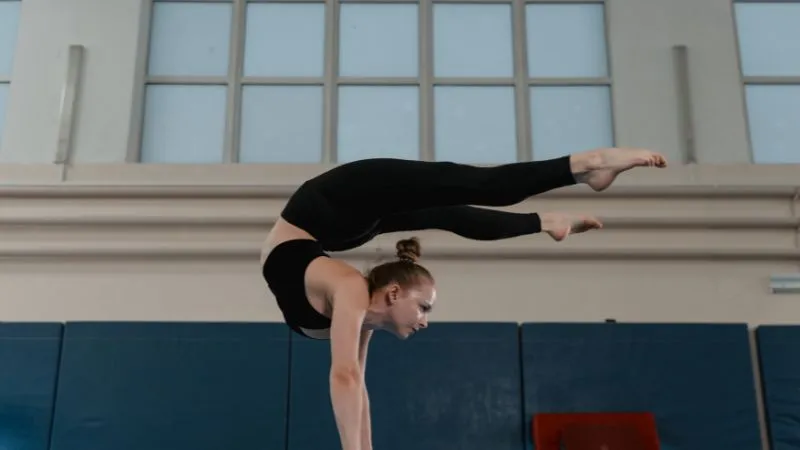Gymnastics is a sport that blends agility, balance, and strength to produce breathtaking performances. Twisting gymnastic movements, in particular, increase the intricacy and thrill of routines.
These dynamic movements entail controlling and precisely rotating the body around its axis. Weaving aspects of the gymnast’s floor routines, vaults, and bars demonstrate their command of both skill and creativity.
Besides relying on slim products and massagers, everyone should practice exercises and gymnastics to become fit. In this post, we’ll look at 10 twisting gymnastic moves that perfectly capture the intriguing fusion of athleticism and originality seen in gymnastics.
Top 10 Twisting Gymnastic Steps 2023
- Aerial Twist
The floor exercise includes a breathtaking motion called the aerial twist. The gymnast launches into the air from one foot in this move, turns their body while in the air, and lands on the other foot. This show of aerial grace requires a high level of coordination and spatial awareness.
- Yurchenko Vault
The Yurchenko vault is a vaulting move different from a round-off entry onto the springboard. Natalia Yurchenko invented it. Gymnasts can add twists to this stunning and technically challenging maneuver during their post-flight phase.
- Twisting Salto
A twisting Salto, which often takes place on the floor exercise and the vault, combines a somersault and a twist. The gymnast creates a captivating spiral effect by flipping in the air while simultaneously twisting their body around the axis. There are single, double, and even triple-twist variations of this movie.
- Twisted Layout
Both the men’s and women’s artistic gymnastics disciplines frequently use the twisting layout. This move involves the gymnast extending their body straight while performing twists in the air. The crisp lines and elegant movement of the winding pattern are what give its appeal.
- Backflip with a Full Twist
This move combines twisting and flipping in an original way. Gymnasts rotate their bodies 360 degrees as they do a backflip. It frequently appears on the floor exercise and balancing beam, and perfect time and accuracy are needed for its execution.
- Giant Twisting on Uneven Bars
Routines on uneven bars highlight a gymnast’s upper body strength and smooth transitions. A large swing that rotates around the bar while incorporating twists adds another level of difficulty.
- Double Full Twist on Floor
Completing the floor exercise’s two consecutive full twists takes tremendous skill. Gymnasts begin with a forward takeoff, twist twice while holding a tucked or piked position, and land with amazing grace.
- Twisting Tsukahara
Another gymnastics fundamental is the Tsukahara vault, which involves the gymnast’s back handspring onto the vaulting table. The difficulty of this move is increased by adding a twist.
- Rudolph on the Beam
The balance beam is a difficult device that requires balance and accuracy. The Rudolph is a backflip with a half twist on the shaft that bears Kurt Thomas, a gymnast’s name.
- Twisting Double Layout
The twisting double layout, one of the most challenging and artistically attractive feats, is frequently only performed by top gymnasts. Twists and two flips need a lot of strength, control, and expertise to execute.
How Can I Conduct Twisting Gymnastic Challenges?
Challenge: “Twist Progression Journey”
Duration: 4-8 Weeks
Objective: To progressively improve your twisting gymnastics skills while staying safe and injury-free.
Weeks 1-2: Foundation and Assessment
- Start by evaluating your existing twisting skills. Find out your areas of strength and progress.
- Concentrate on fundamental maneuvers, including simple aerials, twisting jumps, and basic twists.
- Through specific workouts, work on improving your flexibility and core strength.
Weeks 3-4: Twisting Skill Development
- Pick only one twisting technique you want to get better at. It might involve the floor, the vault, or the bars.
- Dissect the skill into its constituent parts, then practice each piece separately.
- Your twisting exercises should have more repetitions and sets as you steadily increase your endurance and control.
Weeks 5-6: Adding Complexity
- Introduce advancements to the twisting technique you’ve chosen. Try adding an extra half twist, for instance, if you’re working on a layout that twists.
- Practice linking various twisting pieces together to form combinations.
- Maintain your attention on technique, flexibility, and core strength.
Weeks 7-8: Mastery and Showcasing
- Improve the execution and landing of your preferred twisting technique.
- To track your development, videotape your practice sessions.
- Post your accomplishments on social media or with your local gymnastics community to celebrate your development.
Final Remarks
In conclusion, taking a gymnastics challenge that involves twisting is enjoyable. You can advance at your own rate while practicing consistently, making clear goals, and honing your twisting techniques over time. Always keep safety first, have a happy attitude, and recognize your accomplishments as you go. You’ll discover yourself gaining new proficiency levels and relishing the thrilling world of twisting gymnastics if you’re dedicated and determined.
FAQ’s
- Are gymnastics twists challenging to learn?
Gymnastics twists come in a variety of complexity levels, from simple twists to sophisticated ones.
- Do I need to be flexible to engage in gymnastics involving twisting?
In gymnastics, flexibility is crucial for maneuvers that include twisting.
- Can I begin gymnastics twisting as an adult?
Yes, even as an adult, you can start learning gymnastics.

